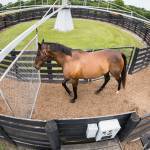What’s It Like to be a KER Research Horse?

Readers who see the words “animal” and “research” in the same sentence may wonder about what really happens to a horse or other animal that’s used for scientific studies. How different is the life of a research horse from that of a racehorse, or a dressage mount, or a pony used for trail riding?
Horses at the Kentucky Equine Research (KER) facility are frequently turned out in large pastures in groups of two to four. They spend some time in spacious, airy stalls bedded with rubber mats and wood shavings. They learn to run on a high-speed treadmill that can be used to simulate race training, and also work in a mechanical exerciser that allows untethered horses to walk and trot in a large circle at varying speeds.
Horses involved in a nutrition study are fed precisely measured amounts of hay and grain; horses not being used in current research usually spend their days grazing with their pasturemates. All of the horses get regular vaccinations, dental checkups, dewormings, and farrier care.
For these horses, the day-to-day activities aren’t much different than those of many other horses in training or riding programs. To learn more about what it’s like to be a KER research horse, click here.








